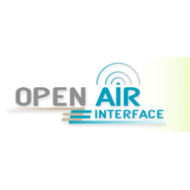Inside OpenAirInterface
- Track: Software defined radio devroom
- Room: AW1.125
- Day: Sunday
- Start: 14:45
- End: 15:15

We provide an overview of the OpenAirInterface.org (OAI) 3GPP LTE SDR MODEM and protocol stack for x86-based systems. We focus on the objectives, some of the history of the project and its primary technical aspects. We also provide information regarding the newly created Software Foundation around OAI to encourage open-source development for 5G radio systems in conjunction with the imminent standardization phase.
OpenAirInterface today
OpenAirInterface (OAI) currently provides a standard-compliant implementation under a GNU GPLv3 license of a subset of Release 10 LTE for terminal (UE), basestation (eNodeB), and core network (EPC - MME, HSS, SGw and PGw) on standard Linux-based computing equipment (Intel x86 PC architectures). It can be used in conjunction with standard RF laboratory equipment available in many labs (i.e. National Instruments/Ettus USRP and soon PXIe platforms) in addition to custom RF hardware provided by EURECOM to implement these functions to a sufficient degree to allow for real-time interoperation with commercial devices. Some industrial users have reported working OAI-based systems integrated with commercially-deployable remote radio-head equipment and have provided demonstrations at major industrial tradeshows (Mobile World Congress Asia 2014, Mobile World Congress Barcelona in 2013, IMIC 2013). The current major industrial users of OpenAirInterface for collaborative projects are Agilent, China Mobile, IBM, Alcatel-Lucent, Thales, National Instruments and Orange. The primary future objective is to provide an open-source reference implementation which follows the 3GPP standardization process starting from Rel-13 and the evolutionary path towards 5G and that is freely-available for experimentation on commodity laboratory equipment.
We detail some of the inner workings of OAI, in particular SIMD optimizations for real-operation and efficient numerical simulation of radio systems as well as information regarding tools used in the development of the protocol stack. We also provide some use cases of OAI experimental research as well as some the methodologies used for proof-of-concept design (simulation, testing and deployment).
A bit on the need for open-source tools for 5G cellular evolution
Open-source has made a very significant impact in the extremities of current networks, namely in the terminals due to the Android ecosystem and in cloud infrastructure due, in part, to the OpenStack ecosystem. The OpenAirInterface Software Foundation aims to provide a similar ecosystem for the core (EPC) and access-network (EUTRAN) of 3GPP cellular systems with the possibility of interoperating with closed-source equipment in either portion of the network. In addition to the huge economic success of the open-source model, the Foundation will be a tremendous tool used by both industry and academia. More importantly it will ensure a much-needed communication mechanism between the two in order to bring academia closer to complex real-world systems which are controlled by major industrial players in the wireless industry. In the context of the evolutionary path towards 5G, there is clearly the need for open-source tools to ensure a common R&D and prototyping framework for rapid proof-of-concept designs.
About the Foundation
The Foundation is a non-profit organization ("Fonds de Dotation") founded by EURECOM, a world-renowned research institute in telecommunications and creator of OAI. EURECOM has been encouraged by the European Commission to extend OpenAirInterface to help in the definition of 5G systems. To this end, the Foundation will help drive innovation in 5G by following the standard as it is being drafted and, through quick interaction with 3GPP, will leverage the crowdsourcing effect both from industrial and academic users. It strives to make OpenAirInterface become the de facto reference implementation for new 3GPP standards through its open-source policy starting from Release 13 LTE. The resulting development can be used in both publicly-funded collaborative projects as well as industry-driven initiatives aiming to demonstrate 5G features at the earliest possible stage. Moreover, the results can be replicated in several locations independently through the combination of open-source and commodity hardware. This then becomes a truly distributed experimental facility with a very large number of potential contributors.
Speakers
| Raymond Knopp |